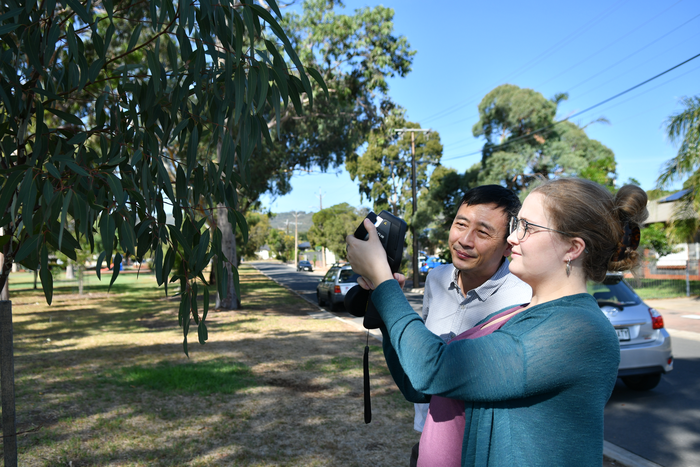Stormwater harvesting is a cool way to keep streets green
Research has found stormwater interception and infiltration is proving effective for a shady tree canopy in concrete urban environments.

[Apr 2, 2022: Karen Ashford, Flinders University]
Associate Professor Huade Guan and Xanthia Gleeson use a handheld camera to monitor tree growth. (CREDIT: Flinders University)
Reports of tree canopy coverage dwindling across city suburbs raise pressure on local government and other authorities’ efforts to improve the health of urban street trees.
Flinders University research has found stormwater interception and infiltration that allows water to soak into tree root zones is proving effective for a shady tree canopy in concrete urban environments where extreme heat occurs regularly.
The new study, published in Frontiers of Climate, examines how growth, water use, leaf-level gas exchange and productivity of white cedar (Melia azedarach) trees has benefited from a popular stormwater harvesting device, the TREENET Inlet. This intercepts stormwater runoff from roads and soaks it into the soil through a porous well around street trees.
“Increased land surface sealing due to urbanisation and building homes and infrastructure has decreased rainfall infiltration to the soil, decreased vegetation cover and increased demand on mains water resources,” says lead researcher, Flinders University Environmental Science graduate and PhD candidate Xanthia Gleeson.
Image credit: md.water.usgs.gov
“As a result, city water management projects using stormwater harvesting and infiltration are increasingly combined with urban greening to support adaptation and resilience to the changing climate,” she says.
Related Stories
The study shows that stormwater harvesting and infiltration by TREENET Inlets provides significant benefit to white cedar trees growing in a suburban street in the City of Mitcham, with mature trees transpiring 17% more water on average for more than a year, and 21% more during dry seasons.
White cedar saplings with stormwater harvesting grew 65% more in height and 60% more in diameter at breast height over a three-year period than saplings without stormwater harvesting.
This is consistent with observed 106% greater stomatal conductance and up to 169% greater photosynthesis rate in dry seasons for saplings supported by harvested stormwater.
The stormwater inlets not only provide 20% more water for cedar tree transpiration in summer but assist root zone moisture at night, when moisture update accounts for about 25% of total daily tree water use.
To comprehend the benefits of water sensitive urban designs (WSUD) for improving our environment, Flinders University researchers are investigating how various WSUD implementations may have helped relieve tree water stress in the City of Mitcham over the past five years.
“It’s clear this passive irrigation directly into street tree root zones greatly benefits mature trees,” says lead author, Flinders University researcher Associate Professor Huade Guan, from the National Centre for Groundwater Research and Training.
“It makes sense because increased stormwater discharge presents risks to marine and other ecosystems, and infiltration in-situ is a low-cost and sustainable alternative.
“Quick urban drainage exacerbates the heat island effects which is raising the stakes on the health and lifestyle risks of extreme climate events under climate change. We need to do more to mitigate the problems as we face more extreme climate events, with summer maximum temperatures likely to reach 50C by 2050,” Professor Guan says.
The article, Enhanced passive stormwater infiltration improves urban Melia azedarach functioning in dry season (2022) by Xanthia Gleeson, Tim Johnson, Gobert Lee, Yifei Zhou and Huade Guan has been published in Frontiers in Climate DOI: 10.3389/fclim.2022.783905
For more science and technology news stories check out our New Discoveries section at The Brighter Side of News.
Note: Materials provided above by Flinders University. Content may be edited for style and length.
Like these kind of feel good stories? Get the Brighter Side of News' newsletter.
Tags: #New_Discoveries, #Trees, #Green_Good_News, #Water_Capture, #Science, #Research, #Run_Off, #Global_Warming, #The_Brighter_Side_of_News
Joseph Shavit
Head Science News Writer | Communicating Innovation & Discovery
Based in Los Angeles, Joseph Shavit is an accomplished science journalist, head science news writer and co-founder at The Brighter Side of News, where he translates cutting-edge discoveries into compelling stories for a broad audience. With a strong background spanning science, business, product management, media leadership, and entrepreneurship, Joseph brings a unique perspective to science communication. His expertise allows him to uncover the intersection of technological advancements and market potential, shedding light on how groundbreaking research evolves into transformative products and industries.



